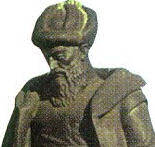 Sinan was a great architect who grew up in one of the most splendid periods of the Ottoman State, and who contributed to this era with his works.
Sinan was a great architect who grew up in one of the most splendid periods of the Ottoman State, and who contributed to this era with his works.
Various sources state that Sinan was the architect of around 360 structures which included 84 mosques, 51 small mosques (mescit), 57 schools of theology (medrese), 7 schools for Koran reciters (darülkurra), 22 mausoleums (türbe), 17 Alm Houses (imaret), 3 hospitals (darüşşifa), 7 aquaducts and arches, 48 inns (Caravansarai), 35 palaces and mansions, 8 vaults and 46 baths. Sinan, who held the position of chief architect of the Palace, which meant being the top manager of construction works of the Ottoman Empire, for nearly 50 years, worked with a large team of assistants consisting of architects and master builders.
The development and maturing stages of Sinan can be marked with three major works. The first two of these are in Istanbul - Sehzade Mosque which he calls his apprenticeship period work, Süleymaniye Mosque which is the work of his qualification stage, and Selimiye Mosque in Edirne the product of his master stage. Sehzade Mosque is the first of the grand mosques Sinan has created. Mihrimah Sultan Mosque which is also known as the Uskudar Quay Mosque was completed in the same year and has an original design with its main dome supported by three half domes. When Sinan reached the age of 70, he had completed the Süleymaniye Mosque and its Complex. This building, situated on one of the hills of Istanbul facing the Golden Horn, and built in the name of Süleyman the Magnificent between 1550-57, is one of the symbolic monuments of the period. The diameter of the dome which exceeds 31 meters at Selimiye Mosque which Sinan completed when he was 80, is the most significant example of the level of achievement Sinan reached in architecture. Mimar Sinan has reached his artistic summit with the design, architecture, tile decorations, land stone workmanship displayed at Selimiye.
Another area of architecture where Sinan delivered unique projects are the mausoleums. Mausoleum of Sehzade Mehmed gets attention with its exterior decorations and sliced dome. Rüstem Pasha mausoleum is a very attractive structure in classical style. The mausoleum of Süleyman the Magnificent which is one of his most interesting experimentations has an octagonal body and flat dome. Selim II Mausoleum with has a square plan and is one of the best examples of Turkish mausoleum architecture. Sinan's own mausoleum which is located at the north-east part of the Süleymaniye complex on the other hand, is a very plain structure.
Sinan, in the bridges he built over the rivers, has masterfully combined art with functionalism. The largest of his work in this group is the nearly 635 meters (2083 feet) long Büyükçekmece Bridge in Istanbul. Other significant examples are Silivri Bridge outside of Istanbul, Lüleburgaz (Sokullu Mehmet Pasha) Bridge on Lüleburgaz River, Sinanli Bridge over Ergene River and Drina Bridge which has became the title of the famous novel of Yugoslav author Ivo Andriç.
While Sinan was maintaining and improving the water supply system of Istanbul, he has built arched aqueducts at several locations within the city. Maglova Arch over Alibey River, which is 257 meters (843 feet) long, 35 meters (115 feet) high and displaying two layers of arches is one of the best samples of its kind.

